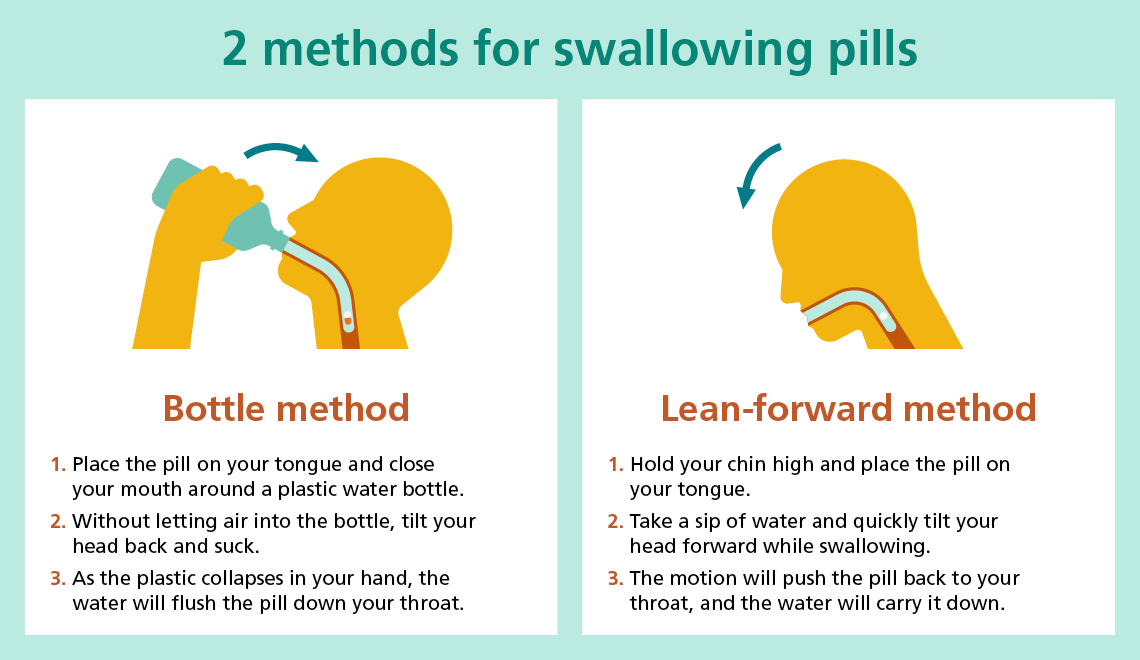4 ways to make swallowing pills easier
.png)
Sometimes medication doesn’t seem to want to drop into your belly. So we asked an expert how to swallow with skill.
Most of us will take a daily pill at some point in our lives. But getting it to go down smoothly can be a struggle, especially if you’re taking multiple medications at once. Among 100 patients surveyed at a clinic in Iowa, half reported some degree of trouble getting pills down their throats.
“Difficulty swallowing pills can occur for several reasons,” says Alyssa Wozniak, PharmD, a clinical assistant professor at D’Youville School of Pharmacy in Buffalo, New York. Dry mouth, fear of swallowing tablets or medical illnesses such as stroke or Parkinson’s disease can all play a role. And some pills are simply more difficult to wolf down than others, says Wozniak.
The inability to swallow can be frustrating or even scary, such as when the pill becomes stuck in your throat. In extreme cases, if a pill is lodged and won’t go down, you may need to visit the emergency room. Certain medications can irritate the esophagus, says Wozniak. “And if you have this feeling often, especially if you have trouble swallowing things other than pills, it is important to seek medical attention to rule out conditions that could be causing this,” she says.
For some people, it’s also helpful to avoid taking pills right before going to bed. “Lying down can sometimes lead to feeling as if the pill is stuck,” says Wozniak. But in most cases, you can wash a stuck pill down with more water.
Better yet, you can prevent the problem — and make sure your medications go down smoothly every time — with these 4 tips.
Let Optum Store manage your prescriptions for you. Sign up for home delivery and access our best prices. No insurance required.
Tip #1: Sip water before you swallow your pill.
You probably already drink water to rinse the pill down. That’s good! Keep doing that. But add an extra step: Drink before you introduce the pill.
“Wetting your mouth and throat prevents pills from getting stuck due to dryness,” says Wozniak. “And drinking after you swallow the pill also prevents it from getting stuck in your throat.”
And stick to water, says Wozniak. “Other drinks, such as dairy or fruit juices, can interact with certain medications,” she says.
Tip #2: Use the bottle method for tablets and the lean-forward method for capsules.
A study published in the Annals of Family Medicine evaluated 2 pill-swallowing techniques: the bottle method and the lean-forward method. And they worked. The techniques improved swallowing in 60% and 89% of patients, respectively.
“To try the bottle method, first place the pill on your tongue,” says Wozniak. “Close your lips tightly around a water bottle,” and then suck as you tilt your head back. Don’t let air into the bottle, says Wozniak. You should feel the plastic collapse as the contents drain.
For the lean-forward method, which is best for capsules, start either sitting or standing with your chin up and shoulders back. “Place the pill in your mouth, then take a sip of water and quickly tilt your head forward while swallowing,” says Wozniak. “That moves the pill toward the back of your throat and takes your mind off the work of swallowing.”

Tip #3: Try a gel or spray to make the pill go down easier.
Thankfully, there are products available to help your medications go down smoothly.
Gels coat pills and make them more slippery. “They may also improve the taste of certain medications or limit the ability to feel the pill sliding down your throat,” Wozniak says. Phazix® is one gel to look for at your pharmacy.
Sprays, on the other hand, work on your throat directly. “When a spray is puffed into the back of the mouth and throat, it can lubricate the oral passage and mask unpleasant taste,” says Wozniak. Pill Glide Swallowing Spray® is an example of one you might find useful.
Regardless of which product you choose, Wozniak recommends talking to your doctor or pharmacist first. You want to be sure it won’t interact with your medication or condition.
Tip #4: Practice taking pills. (It's great for kids.)
Swallowing a pill is a skill, and it’s one children can learn.
“Your child can practice with something small, such as a sprinkle,” says Wozniak. “Have the child place the ‘pill’ on their tongue and take a drink to wash it down their throat.” Then you can increase the size to a miniature chocolate chip or Tic Tac.
Children can also try the bottle method, outlined above, or they can place the pill on their tongue and drink with a straw. If those techniques don’t work, have the child take a drink, hold the water in their mouth and tilt their head back. Then place the pill in their mouth and have them swallow it all in one gulp, says Wozniak.
It might feel frustrating to have to learn a simple skill such as swallowing. But pills are tiny, and they require a technique that doesn’t always feel natural. Once you find a method that works, you’ll never struggle again.
Don't have time to see your doctor in-office? Optum Store's virtual care service can help out in a pinch. Our licensed physicians are available remotely. No insurance needed.
Additional sources
Half of people have difficulty swallowing pills: Current Therapeutic Research, Clinical and Experimental. (2015). “Pill Properties that Cause Dysphagia and Treatment Failure.”
Bottle method and lean-forward method: Annals of Family Medicine. (2014). “Two Techniques to Make Swallowing Pills Easier.”
Gels and sprays can help pills go down: Patient Preference and Adherence. (2018). “A spoonful of sugar helps the medicine go down? A review of strategies for making pills easier to swallow.”
Pills that should not be crushed: Institute for Safe Medication Practices